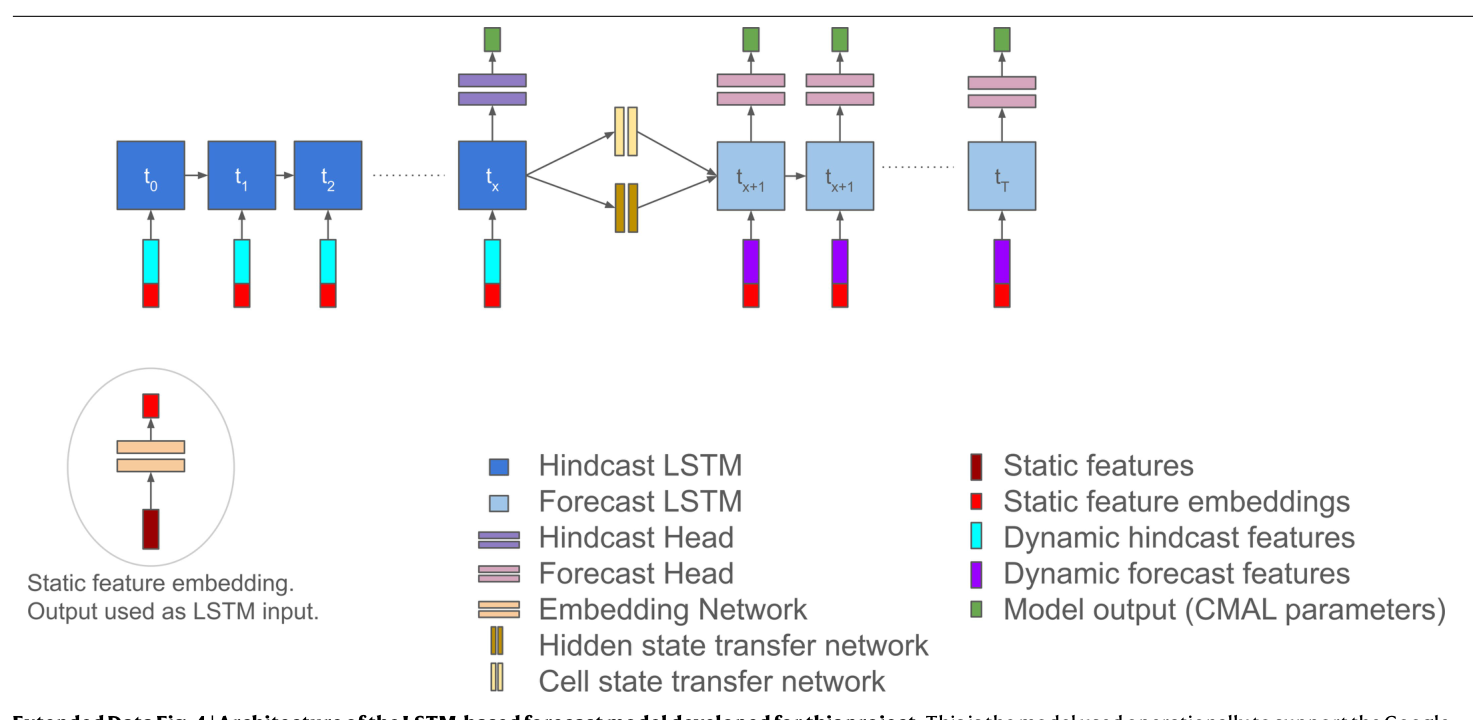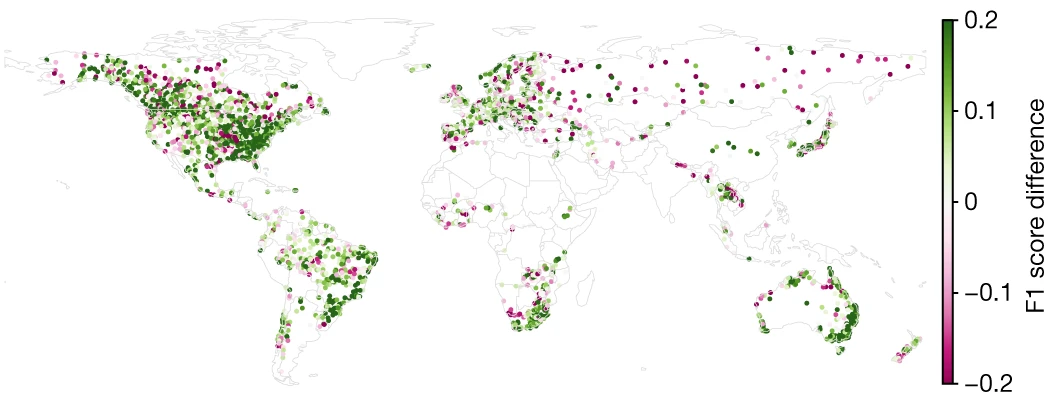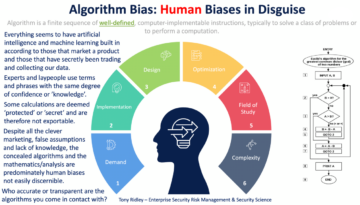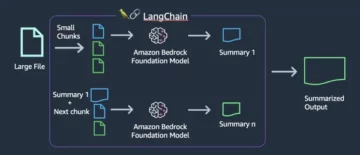Introduction
Floods disproportionately impact developing countries with sparse streamflow gauge networks, highlighting the need for accurate early warnings. The acceleration of flood-related disasters due to climate change underscores the urgency for effective early warning systems, especially in low- and middle-income countries where 90% of vulnerable populations reside. According to the World Bank, upgrading flood early warning systems in developing nations to developed standards could save an average of 23,000 lives annually. However, challenges persist, including the necessity for individual watershed calibration and limited forecasting in vulnerable regions. In this article, we will understand the research paper by Google that explores using artificial intelligence (AI) to predict riverine flooding up to 5 days in advance, detailing its potential implications for over 80 countries, particularly in data-scarce and vulnerable regions.

Table of contents
The Devastating Impact of Floods
Floods are the most common type of natural disaster, and the rate of flood-related disasters has more than doubled since 2000. This increase is attributed to the accelerating hydrological cycle caused by anthropogenic climate change. Flood impacts are particularly severe in developing countries, where populations are highly vulnerable to flood risks. The devastating consequences of floods underscore the urgent need for accurate and timely flood warnings to mitigate the impact on human lives and property.
The Current State of Flood Forecasting
The current state of flood forecasting faces challenges, particularly in ungauged basins where hydrological prediction models need more reliable data for calibration. This limitation hinders flood forecasts’ accuracy and lead time, especially in areas vulnerable to flooding’s human impacts. The lack of dense streamflow gauge networks in developing countries further exacerbates the inaccuracy of flood warnings, highlighting the critical need for improved global access to reliable flood forecasts.
A Ray of Hope: Google AI to the Rescue
Google Artificial Intelligence (AI) presents a promising solution to the challenges of global flood forecasting. By leveraging AI and open datasets, there is potential to significantly improve the precision, recall, and lead time of short-term forecasts of extreme riverine events. The development of an operational system that produces publicly available forecasts in real-time in over 80 countries demonstrates the potential of AI to provide early and accurate flood warnings in ungauged basins. This marks a significant advancement in enhancing global access to reliable flood forecasts and early warning systems.
[embedded content]
Google Research Paper: AI Revolutionizes Flood Forecasting
The Google research paper presents a significant advancement in flood forecasting using artificial intelligence (AI) trained on open and public datasets. The study evaluates the potential of AI to revolutionize global access to forecasts of extreme events in international rivers. By leveraging AI, an operational system has been developed to produce short-term (7-day) flood forecasts in over 80 countries, providing real-time forecasts without barriers to access, such as monetary charges or website registration.
Using AI for Global Flood Forecasts
The Google research paper delves into the use of AI for global flood forecasts, highlighting the development of an AI streamflow forecasting model that extends previous work on hydrological nowcast models. The model utilizes long short-term memory (LSTM) networks to predict daily streamflow through a 7-day forecast horizon. Notably, the AI model does not use streamflow data as inputs, addressing the challenge of real-time data availability, especially in ungauged locations. The model architecture incorporates an encoder-decoder model with separate LSTM units for historical and forecast meteorological input data.

From Open Data to Real-Time Forecasts
The operational system developed based on the AI model provides real-time flood forecasts in over 80 countries, marking a significant milestone in improving global access to reliable flood warnings. The system’s ability to produce short-term forecasts without barriers to access, as demonstrated by the availability of forecasts in real-time
and free of charge, underscores the potential of AI to enhance early warning systems for flood events.
Beyond State-of-the-Art
The AI model’s performance surpasses the current state-of-the-art global modeling system, the Copernicus Emergency Management Service Global Flood Awareness System (GloFAS). The study reports that AI-based forecasting achieves reliability in predicting extreme riverine events in ungauged watersheds at a lead time of up to five days, comparable to or better than the reliability of nowcasts from GloFAS. Additionally, the AI model’s accuracy over five-year return period events is similar to or better than current accuracies over one-year return period events, indicating its potential to provide early and accurate flood warnings over larger and more impactful events in ungauged basins.
Under the Hood: The AI Model
Building the Brains
The AI streamflow forecasting model extends previous work on hydrological nowcast models using LSTM networks to simulate sequences of streamflow data from meteorological input data. The model uses an encoder–decoder architecture with one LSTM running over a historical sequence of meteorological input data (the encoder LSTM) and another LSTM running over the 7-day forecast horizon with inputs from meteorological forecasts (the decoder LSTM). The model does not use streamflow data as inputs due to the unavailability of real-time data in ungauged locations, and the benchmark (GloFAS) does not use autoregressive inputs. The dataset includes model inputs and streamflow targets for 152,259 years from 5,680 watersheds, with a total size of 60 GB saved to disk.
The Data Timeline
The figure shows the available data periods from each source used for training and prediction with the AI model. During training, missing data was imputed either by using a similar variable from another data source or by imputing with a mean value and adding a binary flag to indicate an imputed value. The model uses a hindcast sequence length of 365 days, with a hidden size of 256 cell states for both the encoder and decoder LSTMs.

How Well Does the AI Model Predict?
The performance of the AI model was assessed using cross-validation experiments, with data from 5,680 gauges split in time and space to ensure out-of-sample predictions. The model predicts parameters of a single asymmetric Laplacian distribution over area-normalized streamflow discharge at each time step and forecast lead time. The model was trained on 50,000 minibatches with a batch size of 256 and standardized inputs by subtracting the mean and dividing by the standard deviation of training-period data.
Putting the Model to the Test
The cross-validation experiments included splits across continents, climate zones, and groups of hydrologically separated watersheds. The AI model was evaluated out-of-sample in both location and time, and the results were reported over a hydrograph that resulted from averaging the predicted hydrographs from an ensemble of three separately trained encoder–decoder LSTMs.
Evaluating the Model with Hydrograph Metrics
Hydrograph metrics for the AI model and GloFAS overall evaluation gauges were assessed, with scores decreasing with increasing lead time. The results were calculated for the time period 2014-2021, and the metrics were listed in Extended Data Table 1. Additionally, hydrograph metrics for the AI model and GloFAS over the 1,144 gauges where GloFAS is calibrated were evaluated, with scores decreasing with increasing lead time.

What Makes the AI Tick?
Feature importance rankings from reliability classifiers were used to indicate which geophysical attributes determine high versus low reliability in the AI model. The most essential features of the AI model included drainage area, mean annual potential evapotranspiration (PET), mean annual actual evapotranspiration (AET), and elevation. These attributes were correlated with reliability scores, indicating a high degree of nonlinearity and parameter interaction in the model.

Conclusion
While hydrological modeling has matured, many flood-prone regions lack reliable forecasting and early warning systems. The Google research paper demonstrates how leveraging AI and open data can significantly improve short-term forecasts’ precision, recall, and lead time for extreme riverine events. AI-based forecasting offers a promising solution by extending the reliability of current global nowcasts to a 5-day lead time and improving forecast skills in Africa to levels comparable to Europe.
Moreover, providing these forecasts publicly in real-time without access barriers enables timely dissemination of flood warnings. Despite this progress, there is room for further improvement by increasing access to hydrological data to train accurate models and real-time updates through open-source initiatives like Caravan. Enhancing global flood predictions and early alerts is critical for safeguarding millions worldwide from the devastating impacts of floods on lives and property. Combining AI, open data, and collaborative efforts paves the way toward this vital goal.
- SEO Powered Content & PR Distribution. Get Amplified Today.
- PlatoData.Network Vertical Generative Ai. Empower Yourself. Access Here.
- PlatoAiStream. Web3 Intelligence. Knowledge Amplified. Access Here.
- PlatoESG. Carbon, CleanTech, Energy, Environment, Solar, Waste Management. Access Here.
- PlatoHealth. Biotech and Clinical Trials Intelligence. Access Here.
- Source: https://www.analyticsvidhya.com/blog/2024/03/google-ai-predicts-riverine-flood-in-advance/
- :has
- :is
- :not
- :where
- $UP
- 000
- 1
- 152
- 2000
- 23
- 5
- 50
- 500
- 60
- 755
- 80
- a
- ability
- accelerating
- acceleration
- access
- According
- accuracy
- accurate
- Achieves
- across
- actual
- adding
- Additionally
- addressing
- advance
- advancement
- africa
- AI
- Alerts
- an
- and
- annual
- Annually
- Another
- architecture
- ARE
- AREA
- areas
- article
- artificial
- artificial intelligence
- Artificial intelligence (AI)
- AS
- assessed
- At
- attributes
- availability
- available
- average
- averaging
- awareness
- Bank
- barriers
- based
- been
- Benchmark
- Better
- binary
- both
- by
- calculated
- CAN
- caused
- cell
- challenge
- challenges
- change
- charge
- charges
- Climate
- Climate change
- collaborative
- combining
- Common
- comparable
- Consequences
- content
- continents
- correlated
- could
- countries
- critical
- Current
- Current state
- cycle
- daily
- data
- datasets
- Days
- decreasing
- Degree
- delves
- demonstrated
- demonstrates
- dense
- Despite
- Detailing
- Determine
- devastating
- developed
- developing
- Developing Countries
- Development
- deviation
- disaster
- disasters
- disproportionately
- distribution
- dividing
- does
- doubled
- due
- during
- each
- Early
- Effective
- efforts
- either
- embedded
- emergency
- enables
- enhance
- enhancing
- ensure
- especially
- essential
- Europe
- evaluated
- evaluation
- events
- experiments
- explores
- extended
- extending
- extends
- extreme
- faces
- Features
- Figure
- five
- flood
- For
- Forecast
- forecasts
- Free
- from
- further
- gauge
- Global
- Global Access
- goal
- google ai
- Group’s
- Hidden
- High
- highlighting
- highly
- hinders
- historical
- hood
- hope
- horizon
- How
- However
- HTTPS
- human
- Impact
- impactful
- Impacts
- implications
- importance
- improve
- improved
- improvement
- improving
- in
- included
- includes
- Including
- incorporates
- Increase
- increasing
- indicate
- indicating
- individual
- initiatives
- input
- inputs
- Intelligence
- interaction
- International
- into
- ITS
- jpg
- Lack
- larger
- lead
- Length
- levels
- leveraging
- like
- limitation
- Limited
- Listed
- Lives
- location
- locations
- Low
- MAKES
- management
- many
- marking
- max-width
- mean
- Memory
- Metrics
- milestone
- millions
- missing
- Mitigate
- model
- modeling
- models
- Monetary
- more
- most
- Nations
- Natural
- Nature
- necessity
- Need
- networks
- notably
- of
- Offers
- on
- ONE
- open
- open data
- open source
- operational
- or
- over
- overall
- Paper
- parameter
- parameters
- particularly
- paves
- performance
- period
- periods
- pet
- plato
- Plato Data Intelligence
- PlatoData
- populations
- potential
- Precision
- predict
- predicted
- predicting
- prediction
- Predictions
- Predicts
- presents
- previous
- produce
- produces
- Progress
- promising
- property
- provide
- provides
- providing
- public
- publicly
- Rate
- RAY
- real-time
- real-time data
- regions
- Registration
- reliability
- reliable
- Reported
- Reports
- research
- resulted
- Results
- return
- revolutionize
- revolutionizes
- risks
- rivers
- Room
- running
- safeguarding
- Save
- saved
- scores
- separate
- separately
- Sequence
- service
- severe
- short-term
- Shows
- significant
- significantly
- similar
- simulate
- since
- single
- Size
- skills
- solution
- Source
- Space
- sparse
- split
- Splits
- standard
- standardized
- standards
- State
- state-of-the-art
- States
- Step
- Study
- subtracting
- such
- surpasses
- system
- Systems
- table
- targets
- than
- that
- The
- the world
- There.
- These
- this
- three
- Through
- tick
- time
- timely
- to
- Total
- toward
- Train
- trained
- Training
- type
- underscore
- underscores
- understand
- units
- Updates
- urgency
- urgent
- use
- used
- uses
- using
- utilizes
- value
- variable
- Versus
- vital
- Vulnerable
- warning
- was
- Way..
- we
- Website
- WELL
- were
- which
- will
- with
- without
- Work
- world
- World Bank
- worldwide
- years
- youtube
- zephyrnet
- zones










